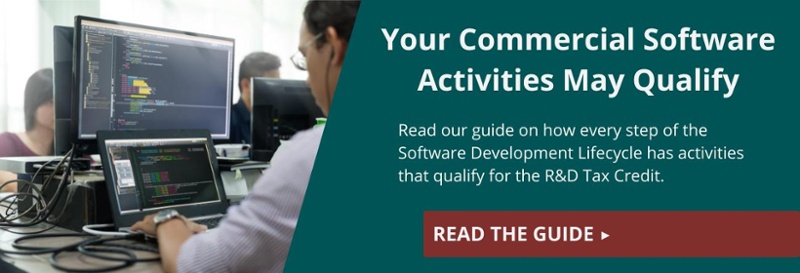
Perhaps you've read that many activities performed during the development of new and enhanced software may qualify for the R&D Tax Credit. After all, the credit is designed to encourage research and development of new and improved products and processes. The credit can help mitigate the risks of innovation and reward your forward thinking.
When looking at the seven main phases of the Software Development Lifecycle (SDLC), the fourth — development and coding — involves activities that offer unique tax credit opportunities, and this article will focus exclusively on those.
Just a quick note. The new regulations were a boon for commercial software vendors, yet you shouldn’t disqualify your company because you don’t market software to third parties. The 2016 Treasury Decision 9786 includes research activities that qualify as Internal Use Software (IUS).
Development and Coding — when work begins in earnest
During this phase, the construction of the major project deliverables happens. Programmers, network engineers, database developers, and others translate requirements and specifications into code within the required technical environment. Quality assurance develops and documents test and user acceptance criteria.
Once this array of development and coding-related activities is complete, unit testing is conducted to ensure all user and business needs are met.
Here are a few commonly overlooked areas that may qualify:
- Iterative process of testing and updating code to achieve the desired result
- Technical, environmental, system, and program documentation
- Supervisors’ and managers’ time involved in leading, directing, and coaching the staff performing qualifying activities
What activity doesn’t qualify? One example is the development of user/help documentation that may occur during this phase.
Documentation is Critical
Because the majority (95%) of qualifying R&D expenses for software relate to employee wages and U.S.-based contractor fees, it’s important to maintain clear and accurate documentation. You need to know exactly how much time is spent working on qualifying activities in order to properly claim R&D Tax Credits.
One standard method is to list each project, all staff involved, and every hour spent on each qualifying activity.
Your documentation must prove:
- The project qualifies for the credit — There’s a risk, and you retain the rights; for instance, a “time and materials project” does not qualify
- The activities qualify — Do the conducted activities pass each part of the Four-Part Test (see below)?
- The amount qualifies — The financial amount you are requesting must be accurate
The Four-Part Test
Once you’ve identified potential qualifying activities, you must run them through the software industry's Four-Part Test to verify:
- Permitted Purpose. This is the activity intended to make or improve either a product or process that results in improved function, performance, reliability, quality or cost efficiency.
- Technical Uncertainty. This is the activity intended to eliminate technical uncertainty when developing or improving a product or process related to methodology, design, techniques, formulas or inventions.
- Process of Experimentation. This is the activity that includes a process of experimentation to eliminate or resolve technical uncertainty. During the process, various alternatives and approaches are evaluated by modeling, simulation, trial and error, prototyping and other methods.
- Technological in Nature. The process of experimentation must rely on the hard sciences (engineering, physics, biology, chemistry, computer science).
Pursuing the R&D Tax Credit for your software development activities can be a complex process. We recommend working with a trusted and experienced partner.
So, now you know a little more about how software development qualifies for the R&D Tax Credit. If you’d like to discuss your software development activities to understand how you may benefit, contact Black Line Group today. We’re sure our proven methodology will deliver an accurate assessment of your ROI.





